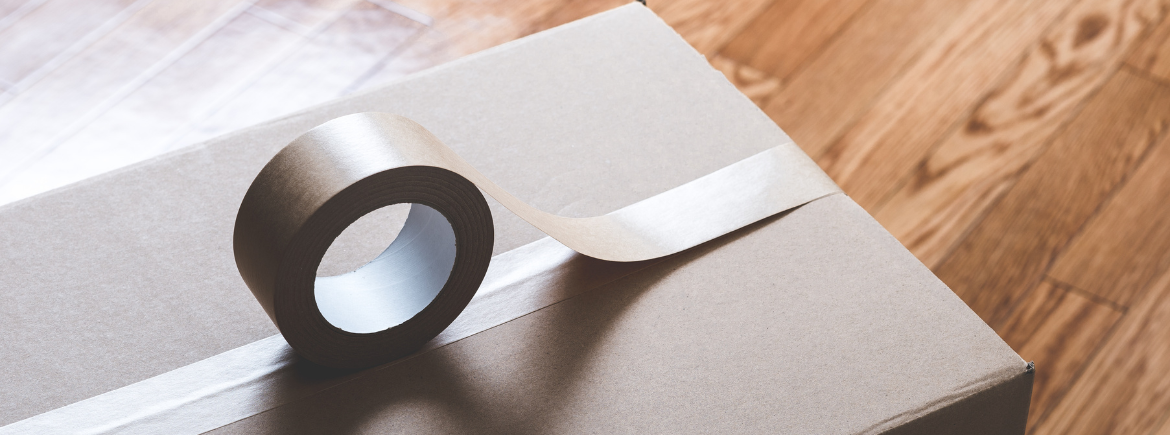A guide to packing tape and adhesive tape

It’s claimed that the average British household has over 200 cardboard boxes delivered every year, and the majority of them will have been sealed with tape.
Being one of the staples of any warehouse, it’ll be hard to find an operation that doesn’t use tape at all in their packing process. But how much do we really know about it?
This blog will be exploring what packing tape is made from, the different types of tape and methods to apply it! We’ll cover common questions about recyclability and help you decide the best tape for your business.
- 1.
- 2.
- 3.
- 4.

What is packing tape made from?
Generally, packing tape is composed of 2 to 3 main parts. Here’s a short explanation of each:
- The backing or carrier – this the physical material tape is made from. In the case of packing tape, the backing is often made from polypropylene, vinyl or kraft paper. Other more technical types might have a backing or carrier made from other materials, such as crepe paper or even cloth.
- The adhesive – this is the stuff that makes tape stick. There are several different adhesives used for parcel tape, including acrylic, solvent, hot melt and even water-activated adhesives.
- The liner – when it comes to packing tape, a liner is sometimes used on some pressure sensitive or double-sided tapes. It stops layers of the backing material from sticking together.
What are the different adhesive types used on packing tape?
Most packing tape will use one of these four adhesives:
- Acrylic – water-based acrylic adhesive is the most popular and low-cost adhesive used on packing tape. It works in a wide range of ambient temperatures, up to 50°C. It has good resistance to discolouration and adhesive bonds it forms get stronger over time. Tapes with acrylic adhesive are primarily applied by hand.
- Solvent – if you are looking for long-term strength, solvent-based adhesives could be great for you, as they can be stuck down with low pressure and form strong bonds. Solvent adhesives have excellent temperature tolerance, working at -4°C up to 65°C. It’s the ideal choice for cold chain environments.
- Hot Melt – when heated, this synthetic resin becomes tacky which creates this adhesive. It is one of the strongest types of adhesive available. It has high initial tack, so is a good option when sealing at speed with electronic tape dispensers. It has a more limited temperature tolerance, so is suited to ambient packing environments.
- Water Activated – this is a starch-based adhesive used on gummed paper tape. It needs to be moistened to activate the adhesive and it solidifies as it dries. It creates strong bonds with cardboard and can provide tamper evidence.
Different kinds of tape dispensers & ways to apply packing tape
- Handheld tape dispensers or tape guns – If you’re packing more than one box, you can use a handheld tape dispenser; it saves time by never losing the end! Designed for use with most self-adhesive tapes, handheld dispensers often have a built-in brake that adjust easily to accommodate varying unwinding speeds. Tape guns come in different sizes for packing tapes with different size cores, too.
- Manual gummed paper tape dispensers – manual gummed paper tape dispensers are reliable and user-friendly. For example, our BP222 model has fifteen manually set lengths and is ideal for use where there is no convenient electrical power supply. Perfect for light to medium usage and compatible with either reinforced or non-reinforced water-activated tapes.
- Automated tape gummed paper tape dispensers – Moisten, cut, and deliver pre-programmed lengths of gummed paper tape. Ideal for medium to high usage.
- Automatic case sealers – for high-demand environments, a case sealer or in-line tape machine is the ideal choice. As a box goes through a case sealer, they apply pressure sensitive tape to the box. They can seal up to 30 boxes per minute, depending on the model. You can also opt for a case sealer that uses glue rather than tape.

Packing Tape Types
There is a wide range of different packing tape types. When you’re looking at which tape to buy, most types will be classified by the material they’re made from and the adhesive they use.
Adhesive tape can be made with:
- Polypropylene
- PVC (also called vinyl)
- Kraft paper
- Crepe paper
- Cloth
- Foam
- Foil
The three most popular materials used for packing tape are polypropylene, PVC and paper.
| Popular Tape Types | |||
| Material | Polypropylene | PVC | Kraft Paper |
| Recommended uses | A good all round packing tape. It can be used in cold storage above 5°C. Polypropylene tape can be printed or coloured. | Stronger than polypropylene, PVC tape is suitable for heavy duty applications. It can be printed or coloured. | Eco-friendly and recyclable, paper tape offers waste and efficiency improvements. It can be made into self-adhesive paper tape or gummed paper tape. It can also be printed with branding. |
| Application methods | By hand or machine | By hand or machine | By hand or machine |
| Cost | Most economical | Mid-range | Premium |
These tapes can come in lots of different variants, like reinforced tape (which contains filaments to make it stronger), tamper evident tape, low noise tape and lots more! For example, if you’re looking for the strongest tape, a reinforced tape with a solvent adhesive would be a great option.

Common questions about packing tape
Below we have listed some popular questions people have around packing tape. If you have any more queries that are not listed, our team of experts will be happy to help you.
What is packing tape used for?
Packing tape is primarily used for sealing cardboard boxes. The adhesive in packing tape forms a bond with the cardboard to prevent boxes from opening during storage or transit.
Can packing tape be recycled?
Whether packing tape can be recycled depends on the type you are using. Most types, such as polypropylene and PVC, are not easily recyclable in the UK.
If you are looking for an eco-friendly option, both polyester adhesive (PET) and paper-based tapes can be recycled. Paper options come in either a self-adhesive or gummed format.
In theory, paper tape may be recycled as part of the paper recycling process; however, UK Recycling facilities have been developed with mechanical processes that separate it from paper and card. The paper products can then be recycled, while the plastic alternatives are usually incinerated for energy recovery.
Water activated tape is by far the most “recycle-friendly” option, as the bond it forms with cardboard means it essentially becomes “part of the box”.
Can I have tape printed with my logo?
Yes, we can offer a wide range of custom print options to meet various requirements. Adding a logo or message to your tape is a great, relatively inexpensive way to customise your packaging quickly and easily.
We can also supply a range of standard printed options, such as fragile tape, as well as floor marking and masking tapes.
Which packing tape is best?
The kind of packing tape you need will depend on the product that you’re sealing.
For a recommendation tailored to your packing processes and product, contact us to speak with one of our packaging experts who will help you determine the best packing tape for your requirements.
How do I choose the right packing tape?
Choosing the right packing tape depends on lots of different factors. You need to consider:
- The boxes you’re packing in (different board grades can impact adhesion)
- The weight of the product you’re packing (heavier parcels may require reinforced tape or a strong adhesive)
- The environment you’re packing your parcels in (e.g. is it cold chain or ambient? This can impact adhesive performance)
- How you want to apply the tape (e.g. some tapes and adhesives are better suited to machine application than others)
- Do you need any special messages or tamper protection?

Support with packing tape
Macfarlane Packaging can supply an extensive range of packing tape, as well as associated machinery, like gummed paper tape dispensers and automatic case sealers. Get in touch today for tailored advice.
